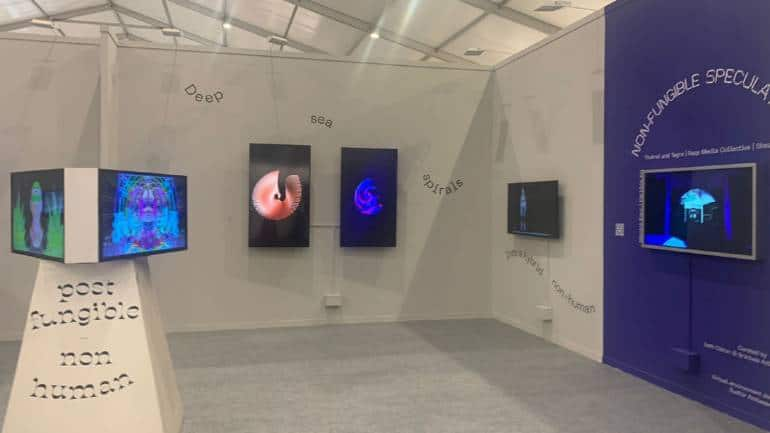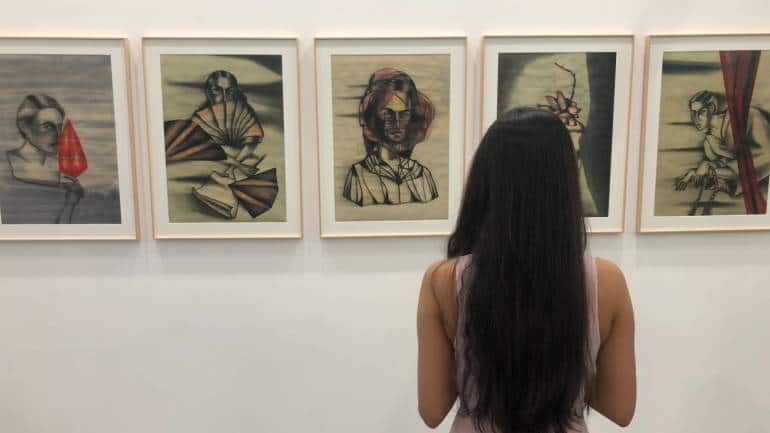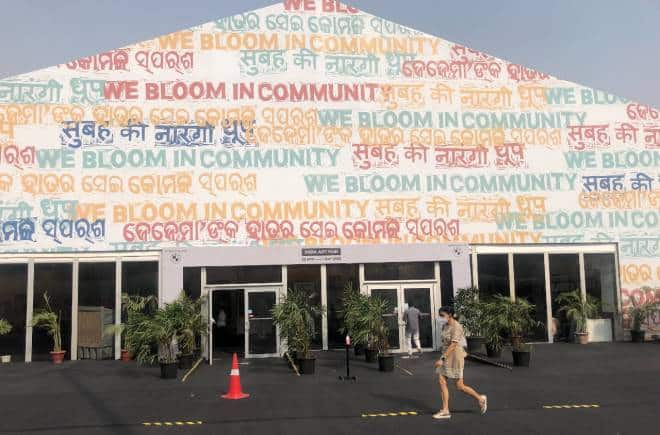



In the cozy confines of The Studio at the expansively carpeted venue of the India Art Fair, rows of tightly wrapped packets of games have replaced framed paintings on the wall. One such game, Weeping Farm, allows up to six players to pick their persona cards and play along crop cycles collecting debt. The player who ends up with the most debt will go on to commit suicide.
"Why should games always be pleasurable?" asks Jiten Thukral, who developed Weeping Farm with fellow artist Sumir Tagra. "A farmer commits suicide every 40 minutes in India and 70 percent of the farmers who kill themselves are women," he adds. The game is part of 'and Archive', a collection of books and game by the Gurugram-based Thukral and Tagra to explore crises like farmer debts, unemployment and climate change. "For me, game design is soft sculpture," explains Thukral. Agrees Tagra, "A game is like an oil painting."
At the 13th edition of the India Art Fair, returning in the physical format after a gap of two years, there are clear indications that games, artificial intelligence and non-fungible token (NFTs) are breaking ground in the country's art market that has managed to withstand the challenges posed by a crushing pandemic. The Studio, housing Thukral and Tagra's games, is a new space at the fair this year, dedicated to art and technology. Also for the first time, the fair has a booth full of digital art that displays a name board with a dot normally seen only in URLs and email ids.
 Non-Fungible Token (NFT) artworks at the booth of Terrain.art.Blockchain Platform
Non-Fungible Token (NFT) artworks at the booth of Terrain.art.Blockchain PlatformAt the booth of Terrain.art, the first blockchain-powered online platform in Indian art market, are works by Chennai's teenager artist Laya Mathikshara who sold the NFT, What if, Moon had life?, last year, and Delhi-based visual artists Amrit Pal Singh and Khyati Trehan. "The future of art viewing and buying is hybrid," says Aparajita Jain, founder of Terrain.art, pointing to the growing interest in digital art in the country.
Augmented reality (AR) is the medium used by Lahore-based artist Muzzumil Jaleel in his installation, Meeting Point, mounted at The Studio space of the fair. The AR installation has five NFTs, each of them a "sculpture of word" representing digitally designed words spoken between people. Exhibited for the first time, Jaleel's 2022 works are Mumbai-based gallery TARQ's first NFTs. One work, which can be scanned on a digital device, is called Point, another, No.
The explosion of digital art in the country is encouraging both buyers and artists. "There is more new media at the fair," says artist Smitha G S. "It is interesting to see many different mediums and experiments," adds the artist from Kozhikode, Kerala, visiting the India Art Fair for the first time. "I sense a lot of dedication behind works other than paintings and sculptures," adds Sreeja Pallam, who along with Smitha, are both participating artists of the Extreme South exhibition that kicked off in the national capital last week.
 The India Art Fair returned in its physical form after two years.Gilded Edge
The India Art Fair returned in its physical form after two years.Gilded EdgeHyderabad-based Faiza Hasan has combined Urdu typography, monochromatic drawings and gilding to design the wrap for BMW's first all-electric car in India, a highlight of the art fair this year. Hasan, who won a new commission, The Future is Born of Art, from the German automaker last month to design the car wrap, calls the work by its name, Suno (an Urdu word which means 'to listen'). There are three more words in Urdu - tasawur (to imagine), umeed (hope) and nigehbaan (to safeguard) - interspersed with portraits of people, including school girls and women drawing kolam.
"What I’ve depicted is a sort of gathering— or coming together— against the backdrop of a common sky," says Hasan, who was coordinator for the Kochi Biennale Foundation's Students Biennale in its 2018 edition. "The four words were carefully chosen," she adds about using language as a tool to create a link between community and sustainability. "Gilding has been an integral part of my drawing practice and is, for me, often a means of mending as well as embellishing."
A new generation of Indian artists like Hasan, Pune-born Rajyashri Goody, whose work of a garland made of leftover food at the Galleryske probing Dalit and Buddhist traditions, and Dharmendra Prasad, who won the Foundation for Indian Contemporary Art (FICA)'s Emerging Artist Award in 2019, are rewriting the country's contemporary art landscape. Among the emerging artists showing their works at FICA's stall at the art fair is Prasad, a Masters in Fine Arts from the Sarojini Naidu School of Arts and Communication, University of Hyderabad.
"The new generation of artists has energised the art fair this year," remarks fair director Jaya Asokan. "Every emerging artist in the country works in the context of the roots of Indian culture as well as contemporary issues," says Samiksha (uses only first name), a Master of Fine Arts from Visva-Bharati University, Santiniketan, who practices art in Dhanbad, Jharkhand.
 A visitor viewing Anju Dodiya's "post-pandemic portraits".
A visitor viewing Anju Dodiya's "post-pandemic portraits".As many as 63 galleries, including four from abroad, and 14 art institutions such as the Kochi-Biennale Foundation, Chennai Photo Biennale Foundation and Aravani Art Project, Bengaluru, are part of the 2022 edition of the India Art Fair, being held from April 28 to May 1 at the NSIC Exhibition Grounds in South-West Delhi's Okhla.
"We have had more than two years of challenging times when people were living with an extended sense of vulnerability and the collapse of medical and economic systems," says Delhi-based Sumakshi Singh, whose 2022 works on thread and lace drawing are the highlights of the Exhibit 320 gallery.
 India Art Fair 2022 at NSIC Exhibition Grounds, Okhla.
India Art Fair 2022 at NSIC Exhibition Grounds, Okhla. Discover the latest Business News, Sensex, and Nifty updates. Obtain Personal Finance insights, tax queries, and expert opinions on Moneycontrol or download the Moneycontrol App to stay updated!
Find the best of Al News in one place, specially curated for you every weekend.
Stay on top of the latest tech trends and biggest startup news.